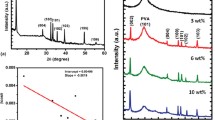Abstract
Inorganic fullerene-like tungsten disulfide (IF-WS2) nanoparticles are useful additives for polymers and lubricating agents, in particular when their surfaces are functionalized by silane modifiers. However, both the success of such a silanization reaction and its effect on the final dispersion quality are still doubtful. In this work, IF-WS2 are functionalized using three different silane modifiers and investigated with X-ray photoelectron spectrometry, infrared spectroscopy, titration, thermogravimetric analysis, and mass spectroscopy. Eventually, they are dispersed within ethanol by sonication to compare the dispersing behavior. The combination of the different analytical techniques revealed that the IF-WS2 surfaces can be functionalized with two of the used silane modifiers, while the third one was repeatedly unsuccessful. The amount of Si on the particles seems to be a fairly clear indication for the success of the functionalization reaction. The IF-WS2 seems to oxidize during the functionalization process, probably producing acidic SO2 or SO3, which can fully acidify a basic surface modifier. The executed treatment without any added silane modifier improved the dispersibility of the IF-WS2 within ethanol to some extent, but added modifiers deteriorated it significantly. TEM images indicate that IF-WS2 particles form aggregates, which might be the reason for the limited dispersibility.








Similar content being viewed by others
References
Rapoport L, Bilik Y, Feldman Y, Homyonfer M, Cohen SR, Tenne R (1997) Hollow nanoparticles of WS2 as potential solid-state lubricants. Nature 387:791–793. doi:10.1038/42910
Shahar C, Zbaida D, Rapoport L, Cohen H, Bendikov T, Tannous J, Dassenoy F, Tenne R (2010) Surface functionalization of WS2 fullerene-like nanoparticles. Langmuir 26(6):4409–4414. doi:10.1021/la903459t
Naffakh M, Díez-Pascual AM, Marco C, Ellis GJ, Gómez-Fatou MA (2013) Opportunities and challenges in the use of inorganic fullerene-like nanoparticles to produce advanced polymer nanocomposites. Prog Polym Sci 38(8):1163–1231. doi:10.1016/j.progpolymsci.2013.04.001
Buchman A, Dodiuk-Kenig H, Dotan A, Tenne R, Kenig S (2009) Toughening of epoxy adhesives by nanoparticles. J Adhes Sci Technol 23(5):753–768. doi:10.1163/156856108X379209
Shneider M, Dodiuk H, Tenne R, Kenig S (2013a) Nanoinduced morphology and enhanced properties of epoxy containing tungsten disulfide nanoparticles. Polym Eng Sci 53(12):2624–2632. doi:10.1002/pen.23517
Ghoreishi SM, Meshkat SS, Ghiaci M, Dadkhah AA (2012) Nanoparticles synthesis of tungsten disulfide via AOT–based microemulsions. Mater Res Bull 47(6):1438–1441. doi:10.1016/j.materresbull.2012.02.042
Shneider M, Rapoport L, Moshkovich A, Dodiuk H, Kenig S, Tenne R, Zak A (2013b) Tribological performance of the epoxy-based composite reinforced by WS2 fullerene-like nanoparticles and nanotubes. Phys Status Solidi A 210(11):2298–2306. doi:10.1002/pssa.201329162
Xu F, Yan C, Shyng YT, Chang H, Xia Y, Zhu Y (2014) Ultra-toughened nylon 12 nanocomposites reinforced with IF-WS2. Nanotechnology 25(32):325701. doi:10.1088/0957-4484/25/32/325701
Späth B, Kopnov F, Cohen H, Zak A, Moshkovich A, Rapoport L, Jägermann W, Tenne R (2008) X-ray photoelectron spectroscopy and tribology studies of annealed fullerene-like WS2 nanoparticles. Phys Status Solidi B 245(9):1779–1784. doi:10.1002/pssb.200779531
NanoMaterials Ltd. (2011) Material safety data sheet NanoLub R, WS\(_{2}\) lubricant nanopowder
ISO 3696:1987 (1987) Water for analytical laboratory use—specification and test methods. Standard, International Organization for Standardization, Geneva
Gutz IGR (version 4) CurTiPot-pH and acid–base titration curves: analysis and simulation freeware
Merkus HG (2009) Particle size measurements, Chap 5. Dispersion of powders in air and in liquids. Springer, New York, pp 117–136. doi:10.1007/978-1-4020-9016-5
Bittmann B, Haupert F, Schlarb AK (2009) Ultrasonic dispersion of inorganic nanoparticles in epoxy resin. Ultrason Sonochem 16(5):622–628. doi:10.1016/j.ultsonch.2009.01.006
Bittmann B, Haupert F, Schlarb AK (2011) Preparation of TiO2/epoxy nanocomposites by ultrasonic dispersion and their structure property relationship. Ultrason Sonochem 18(1):120–126. doi:10.1016/j.ultsonch.2010.03.011
Bittmann B, Haupert F, Schlarb AK (2012) Preparation of TiO2 epoxy nanocomposites by ultrasonic dispersion and resulting properties. J Appl Polym Sci 124(3):1906–1911. doi:10.1002/app.34493
Englert M, Bittmann B, Haupert F, Schlarb A (2012a) Scaling-up of the dispersion process of nanoparticle-agglomerates in epoxy resin with an innovative continuous ultrasonic flow-through-cell dispersion system. Polym Eng Sci 52(1):102–107. doi:10.1002/pen.22051
Englert M, Haupert F, Schlarb AK (2012b) Verification of a dispersion model to describe the dispersion of nanoparticle agglomerates in epoxy resin with a stirred bead mill. J Dispersion Sci Technol 33(8):1240–1246. doi:10.1080/01932691.2010.505112
ISO 22412:2008(E) (2008) Particle size analysis—dynamic light scattering (DLS). Standard, International Organization for Standardization, Geneva
Alexander MR, Short RD, Jones FR, Stollenwerk M, Zabold J, Michaeli W (1996) An X-ray photoelectron spectroscopic investigation into the chemical structure of deposits formed from hexamethyldisiloxane/ oxygen plasmas. J Mater Sci 31(7):1879–1885. doi:10.1007/BF00372203
Flint EB, Suslick KS (1991) The temperature of cavitation. Science 253(5026):1397–1399. doi:10.1126/science.253.5026.1397
Haynes WM (2014) Dissociation constants of organic acids and bases. CRC handbook of chemistry and physics, 95th edn. CRC Press, Boca Raton, pp 5–94
Feldman Y, Zak A, Popovitz-Biro R, Tenne R (2000) New reactor for production of tungsten disulfide hollow onion-like (inorganic fullerene-like) nanoparticles. Solid State Sci 2(6):663–672. doi:10.1016/S1293-2558(00)01070-0
Tenne R, Seifert G (2009) Recent progress in the study of inorganic nanotubes and fullerene-like structures. Annu Rev Mater Res 39(1):387–413. doi:10.1146/annurev-matsci-082908-145429
Panich AM, Kopnov F, Tenne R (2006) Nuclear magnetic resonance study of fullerene-like WS2. J Nanosci Nanotechnol 6(6):1678–1683. doi:10.1166/jnn.2006.211
Chattopadhyay D, Galeska I, Papadimitrakopoulos F (2003) A route for bulk separation of semiconducting from metallic single-wall carbon nanotubes. J Am Chem Soc 125(11):3370–3375. doi:10.1021/ja028599l
Acknowledgements
The authors would like to thank Anja Huch, Beatrice Fischer, Jörg Patscheider, Lassi Karvonen and Matthias Nagel for their experimental and theoretical support.
Author information
Authors and Affiliations
Corresponding author
Electronic supplementary material
Below is the link to the electronic supplementary material.
Rights and permissions
About this article
Cite this article
Haba, D., Griesser, T., Müller, U. et al. Comparative investigation of different silane surface functionalizations of fullerene-like WS2 . J Mater Sci 50, 5125–5135 (2015). https://doi.org/10.1007/s10853-015-9039-4
Received:
Accepted:
Published:
Issue Date:
DOI: https://doi.org/10.1007/s10853-015-9039-4




